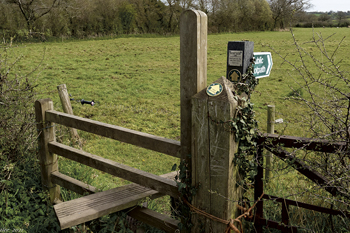
Dear EarthTalk: I would like to plant a few new trees in my backyard, and am looking for guidance on which species are native and would benefit the local ecosystem. Where can I find this kind of information? ~ Susan T., Bangor, ME
Home gardening is a great way to spend time outside, improve local ecosystems and learn more about botany and plants. When it comes to household gardening, natives are the key to success. Planting native species has numerous benefits, including providing food and habitat for native species, especially pollinators. Another important benefit is that native trees will thrive and spread naturally if they are planted in their native environment and suitable climate.

In order to plant the most well-suited flora for your garden to support a holistic, healthy ecosystem, here are some general principles to follow. As previously mentioned, go native! Secondly, look for pollinator friendly species. On a similar note, it could help to do some research on what species, both flora and fauna, are endangered or threatened in your area. Planting threatened tree species can help to support and grow their population numbers. Similarly, finding out which animal species are threatened and planting trees that could be beneficial to their survival would also be beneficial to supporting the local ecosystem. Finally, planting a variety of trees is a great way to support local biodiversity. High biodiversity levels support healthy, productive ecosystems.
Finding just the right species that ticks off all the boxes can be a daunting task. Luckily, there is a plethora of tools out there that can help. For example, Tree Wizard is a tool that helps find tree species that are suitable for specific climates and soil types. Another useful tool is the United States Department of Agriculture (USDA) Climate Change Tree Atlas. This tool specifically looks at how different species’ suitable ranges will change as a result of rising temperatures. This is a helpful tool for determining what tree species will thrive in the future in your area. You can also do research on which species are native to your specific state or region. Most states have an inventory of native trees available through their Department of Natural Resources, as well as an inventory of native animal species.
The bottom line is that planting trees, especially native ones, is massively beneficial to the ecosystem, and is an important step in fighting climate change. Trees provide major ecosystem services, especially carbon sequestration (removing carbon from the air). Trees store large amounts of carbon, and planting large numbers of them can create carbon sinks (defined as anything that absorbs more carbon from the atmosphere than it releases), decreasing the amount of greenhouse gases in the atmosphere. Other ecosystem services provided by trees include increases in biodiversity, support for local populations, and protecting soils from erosion and chemical runoff, which can help to keep water sources clean. Trees are the key to our future, so it is crucial that we do it right!
CONTACTS: arborday.org/shopping/trees/treewizard/intro.cfm; fs.usda.gov/nrs/atlas/
______________________________________________________
Dear EarthTalk: What is the “right to roam” and why is it controversial in the United States? ~ P.K., Bend, OR
The “right to roam” is a concept that allows people to access and enjoy natural areas, such as parks, forests and beaches, without being restricted by private property laws. In essence, it grants people the right to walk or hike freely in the countryside, and to camp, fish and pick berries, among other activities, without obtaining prior permission or paying fees. While this right is well-established in some countries like Scotland and Sweden, it is not a widespread concept in the United States, where the notion of private property is deeply ingrained.

Proponents of the right to roam argue that it promotes physical activity, environmental stewardship and mental health by encouraging people to spend more time outdoors. They also claim that it is a democratic right that allows everyone, regardless of their socio-economic status, to access and enjoy public lands. In addition, they argue that the right to roam can have positive economic effects by stimulating outdoor recreation and tourism.
However, opponents argue that it undermines private property rights, reduces landowners’ incentives to maintain their properties, and can lead to trespassing, vandalism and littering. They also claim that it can pose a threat to public safety by exposing people to dangerous terrain or wild animals.
While the right to roam is not enshrined in U.S. law, some states have passed laws that provide for limited forms of public access to private lands. For example, in some western states, such as Montana and Colorado, people can access certain types of public lands, such as rivers and streams, by crossing private lands without trespassing. Other states, such as Maine and Vermont, have passed “right-to-roam” laws that allow people to access certain types of private lands, such as coastal areas and abandoned railroad beds, for recreational purposes.
Despite these efforts, the right to roam remains controversial in the U.S., with many landowners opposing it as an infringement on their property rights. In some cases, disputes have arisen between landowners and outdoor enthusiasts, with some landowners posting “no trespassing” signs or even blocking access to public lands. Advocates for the right to roam argue that such restrictions violate the public’s right to access public lands and call for greater legal protections for outdoor recreation.
Indeed, the right to roam is a controversial concept in the U.S. that has generated debate between proponents of public access to natural areas and opponents who prioritize private property rights. While some states have taken steps to provide limited access to public lands, there is still a long way to go before the right to roam becomes a widely accepted and legally protected concept in the U.S.
CONTACTS: afar.com/magazine/this-land-is-our-land-places-in-europe-where-access-to-nature-is-a-basic-human; visitsweden.com/what-to-do/nature-outdoors/nature/sustainable-and-rural-tourism/freedomtoroam/; righttoroam.org.uk.
______________________________________________________
Dear EarthTalk: What are the environmental and other pros and cons of ditching the gas guzzler for an electric vehicle (EV)? ~ S.H., Washington, DC
Transportation accounts for almost a third of all U.S. greenhouse gas emissions, making the switch to EVs a welcome change for environmental advocates. But is ditching your old conventional wheels for a shiny new EV really the best thing for the planet? To evaluate how eco-friendly a car is, you should consider the environmental impacts of its three life stages: its creation, operation and disposal.
Studies conclude that manufacturing a vehicle accounts for around 25 percent of its lifetime carbon footprint. Making a car creates a lot of pollution as raw materials have to be extracted, transported and manufactured. In fact, according to the environmental consulting firm Ricardo, 46 percent of an EV’s total carbon footprint is generated before it even travels a mile. Keeping your old car eliminates the environmental effect of manufacturing a vehicle.

An important question arises: Do the negative environmental impacts of manufacturing EV batteries outweigh the benefits? A report by CarbonBrief concludes that EVs have a smaller carbon footprint than used gasoline cars in about four years and a smaller carbon footprint than new ones in around two years. EVs also benefit the environment by eliminating tailpipe emissions and having better fuel economies than gasoline-powered cars. And while the sustainability of EVs ultimately depends upon the mix of renewable energy in the grid where you live, even with the current renewable energy percentage, driving EVs tends to be beneficial. The more renewable energy you charge your car with, the better: So consider choosing your utility’s greener options or purchasing Renewable Energy Certificates (RECs).
EVs themselves pose a bit of a difficulty when it comes to responsible disposal. Recycling EV batteries can be difficult as the design and chemicals vary greatly from one battery to another. Most batteries aren’t even designed to be recycled. While much is being done to address this issue, it remains a significant contributor to toxic waste.
Financially speaking, according to a report by GetJerry, EVs cost an average of $56 per month more to insure than gasoline-powered cars. They are also more expensive to repair. But in spite of these down sides, operating an EV comes with certain economic benefits. It can help you evade the ever-increasing gas prices and the ever-increasing maintenance needs of an aging gas-powered vehicle. It also may be eligible for tax incentives and credits. And prices of battery EVs are seeing significant reductions: According to EVI-USA, “Experts expect that their prices will be at par with diesel or petrol vehicles between 2025 and 2027.”
To conclude, over their full life, electric and hybrid vehicles have significantly lower carbon footprints than normal cars. But, EVs tend to be a bit more expensive. If investing in one is out of reach, you can reduce your transport-related issues by walking, biking or using public transport whenever possible.
CONTACTS: carbonbrief.org; getjerry.com/trends-reports/evs-save-you-gas-money-but-ev-insurance-costs-more; evi-usa.com/will-electric-vehicles-come-down-in-price; epa.gov/greenvehicles/fast-facts-transportation-greenhouse-gas-emissions.

